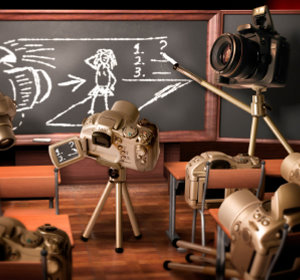12 Signposts on the Road to Becoming a Photojournalist
-
 Travel, adventure and action are some of the words that come to mind when considering a career in photojournalism; however, hard work, persistence and the willingness to be away from home much of the time are more likely to describe the real life of a photojournalist.
Travel, adventure and action are some of the words that come to mind when considering a career in photojournalism; however, hard work, persistence and the willingness to be away from home much of the time are more likely to describe the real life of a photojournalist. -
Photojournalism is the visual representation of a news story, so the ability to tell a story without words is the most important attribute of a successful photojournalist.
-
Excellent camera skills are one group of tools a photojournalist must have, not just to tell stories, but to capture the story when it happens, which could be only a moment in time. Photojournalists must often shoot in chaotic crowds, dangerous environments or less-than-ideal photographic conditions, which require that they are able to operate their equipment almost unconsciously.
-
The other group of tools a successful photojournalist must learn is the concepts and process of journalism. To tell a story journalistically, whether it’s with words or a photo, you must be able to describe the story with the traditional 5 W’s and 1 H: Who, What, Where, When, Why and How. Typically, a press photo needs the help of a caption to answers all these questions, but a photo a news editor accepts will answer as many as possible without words.
-
If your goal is to become a photojournalist, then you start by acquiring the knowledge and education of the two groups of tools outlined above. A formal education is the best option, especially if you’re a young person. A successful photojournalist not only knows photography and journalism, but also is a student of history and current events. To capture the images that tell stories of today’s world, you must also understand the context of those stories: their place in history, how they effect the world, nations, the economy, readers, etc.
-
If a formal education is not a viable path to becoming a photojournalist for you, then it is possible to self-educate yourself and gain enough experience to be hired by a publication or news service. It’s not an easy path, but it can be followed to success.
-
You will still need to learn the photojournalist’s set of tools: photography techniques, journalism concepts and an understanding of world events. There are many resources to learn how to use your camera equipment like a pro: online tutorials, short courses at community colleges, local photography clubs, etc., plus plenty of practice.
-
To understand what it means to be a successful photojournalist, then read the biographies or biographical information available online of the famous news photographers. Study their work and learn why news editors accepted their photos.
-
A technique you can practice on your own is to shoot casual photos of family members and friends with a photojournalist eye. Compose images of events in their lives, as if they were news stories, and an editor had sent you there on assignment: “Local family adopts stray dog from Humane Society.” “Five-year-old girl learns her ABCs.” “Woman volunteers to be school-crossing guard to contribute to children’s safety.”
-
Once you’ve tried a few of these mock photojournalism practice sessions, you could then approach local non-profit or community organizations and volunteer to shoot photos for their press releases. Ask permission to take a series of pictures of an organization’s director during his or daily activities, as if you were creating a “Day-in-the-Life” photo spread.
-
Although sports photography is generally considered a separate form of photojournalism, ask any of the local children’s athletic leagues to allow you to photograph their games. You’ll gain useful experience about telling a story in photos, capturing a great image that only happens once and managing the process of covering an event.
-
You could also approach local high schools and volunteer to shoot photos of their “lesser” sports. It’s likely a photographer from the local newspaper or a few “official” school photographers will cover the football and basketball games, but may not come to field hockey, soccer or volleyball games.
-
With these experiences, you should have a portfolio of images to approach the editor of your local neighborhood/community newspaper for a part-time position or the opportunity to be an intern and work with the publication’s full-time photojournalists.
-
You then may be able to establish a relationship with one of these working photojournalists, and ask him or her to be your mentor. Having worked with a pro provides you with an education you don’t usually obtain at a university and gives you a reference when you’re ready to seek a full-time position as photojournalist.

A formal education at a traditional university provides the broad range of learning a photojournalist needs. Another option is a photography school, such as the New York Institute of Photography, which offers a free course catalog at http://www.nyip.com/requestinfo/.
